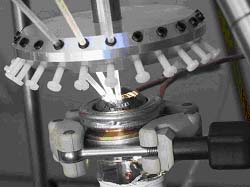Uniquely structured carbon nanomaterials, such as fullerenes (primarily C60) and nanotubes are being explored for a host of promising applications. These constructs with the respective shapes of hollow soccer balls and pipes are being studied worldwide for many applications, which include semiconductor devices, drug delivery systems, extremely strong, chemically resistant composite materials and even micromachines. Discovered only twenty years ago and difficult to produce in quantity, these nanomaterials cost up to $100 per gram, primarily due to the high temperatures required for their manufacture (more than 3000° K for fullerenes and varieties of nanotubes).

Figure 4: Molecules of a fullerene (C60) and carbon nanotube.
Because BIDR’s miniature solar energy collectors can theoretically provide the concentrated photon densities for achieving these immense temperatures, the cost of synthesizing these lucrative materials can be sharply reduced. Research is now under way for designing novel indoor reactors and external solar concentrators, which will provide the optical, thermal, chemical and mechanical balance required for the precisely controlled synthesis of nano-materials.

Figure 5: Nano-material reactor during installation with three fibers positioned on the window of a mirrored dome.